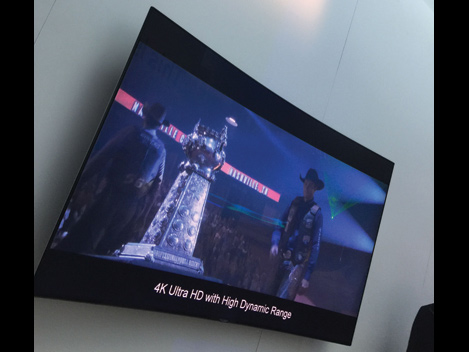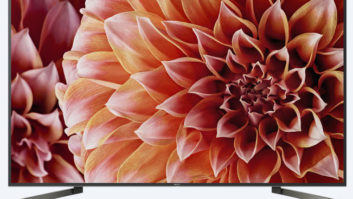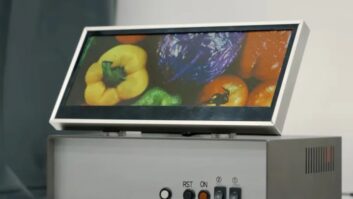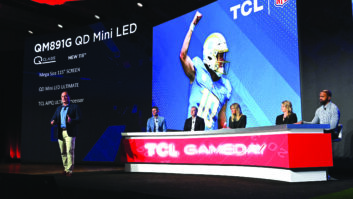
New technologies such as high dynamic range (HDR) and wide color gamut proliferated at CES, promising picture performance described by some as delivering 3D effects without 3D glasses. The 4K Blu-ray format will be one source of such stunning content, but so will 4K streaming services and future ATSC 3.0 TV broadcasts. Those were among the top TV developments at CES, but there was more. Here’s what jumped to the top of the list:
1. 4K Blu-ray: Ultra HD 4K Blu-ray players debuted, though only two companies — Samsung and Philips – plan availability in the next few months. Panasonic plans second-half availability, and other TV vendors are keeping their wicks dry. Hollywood plans around 100 discs in 2016.
For their part, CE suppliers are making conservative market forecasts. “From the manufacturer side, I’ve never seen this type of caution with a new platform,” said Dave Workman, president/CEO of buying group ProSource. “All brands are approaching this with a high degree of caution.”
2. HDR TV range expands: TV suppliers expanded their meager selections of HDR-capable TVs to a wide variety of 4K models, all supporting Open HDR 10 technology but some adding support for Dolby Vision as well.
Ultra HD Blu-ray players unveiled so far support the Open HDR format, as required by the Ultra HD Blu-ray standard, but none yet features Dolby Vision, which is an option in the 4K Blu-ray specs.
HDR TVs and content widen the contrast range between the brightest highlights and the deepest blacks, delivering picture details within the contrast extremes.
At CES, Hisense expanded HDR to all 4K TVs, including a 50-inch 4K at $549 and a 43-inch TV at $399. Sony is bringing Open HDR to seven new models, having offered two 4K TVs in its 2015 lineup with HDR-upgrade capability. LG, meanwhile, is expanding HDR to all of its new 4K OLED and 4K LCD TVs,
Hisense’s Sharp brand unveiled its first 13 4K TVs with HDR, and TCL unveiled its first model, the flagship curved-screen 65-inch X1 targeted for second-half availability. Samsung will continue to offer Open HDR on all 4K TVs in 2016.
3. Dolby Vision HDR surprises: Dolby’s HDR technology is expanding beyond a pair of high-end Vizio TVs to include TVs from Philips, TCL and LG. All of LG’s OLED TVs and Super UHD series of step-up LCD TVs will feature Dolby Vision, as will 55- and 65-inch models in Philips’ 8600 series and TCL’s 65-inch curved-screen X1 with the company’s QUHD display technologies.
Dolby Vision in a TV combines the ability to play back Dolby Vision content as well as other HDR profiles, such as Open HDR 10, based on the SMPTE 2084/2086 standards. Dolby Vision rendering technology in a TV, however, will deliver a higher quality representation of Dolby Vision content compared with a TV that features only Open HDR and is receiving Dolby Vision content, Dolby contended.
4. Gamut gone wild: The flip side of HDR is wide color gamut, and many TV suppliers boasted of gamut close to the full DCI-P3 gamut delivered by digital cinemas. Sharp hit 99.98 percent of P3 in the N9000 series of Aquos TVs consisting of 70-inch flat TV and a $2,999 65-inch curved LED TV due in early to mid-2016.
Hisense got there in a curved 65-inch H10 series model at $2,799. LG hit 99 percent in its OLED TVs and 91 percent in select Super UHD TVs. A new LCD series unveiled by Panasonic also boasts near-P3 color, as do new Samsung LCD TVs.
5. UHD Alliance (UHDA) gets act in gear: The alliance of CE, content-creation and content-distribution companies delivered on its promise to guarantee a stellar 4K consumer experience by setting performance standards for 4K TVs and 4K content, including 4K Blu-ray, streamed and downloaded content. LG, Samsung, Panasonic, Sharp, Hisense, and TCL announced TVs that have already been certified or soon will be.
Those products will wear the Ultra HD Premium logo, which is reserved for products and content that comply with minimum requirements for resolution, bit depth, high dynamic range, peak luminance, black levels and wide color gamut, among other things.
TVs must deliver more than 90 percent of the DCI-P3 digital cinema standard, 10-bit color, 3,840 by 2,160 resolution, and high dynamic range meeting one of two standards: 0.05 to 1,000-plus nits of peak brightness (achievable by LCD TVs) or less than 0.0005 to 540- plus peak nits (achievable by OLED TVs).
Samsung said its entire 2016 SUHD TV lineup has been certified. All LG OLEDs meet the standards, but none of LG’s Super UHD LCD TVs do, given that none meets the 1,000-nit peak-brightness level, and some achieve only 84 percent of P3 gamut.
Sharp said two of its Aquos TVs meet the standards: the $3,299 70-inch N9100U and the $2,999 curved 65-inch N9000U. Hisense’s “certifiable” TV is the $2,799-suggested 65-inch curved. Its predecessor, the 65H10, will get a firmware update in late January to meet the standard.
Sony hasn’t said whether it would apple for certification.
At least 100 certified movie titles will be available on physical 4K Blu-ray discs in 2016 from multiple studios, and streaming titles are also planned. About a dozen 4K digital titles already available from Fox through Vudu meet alliance requirements, Fox told TWICE.
6. UHDA wiggle room: UHD Alliance standards might guarantee high performance levels, but that doesn’t mean every certified 4K title will look the same from one certified TV to the next. For one thing, the standards are tighter for TVs than they are for content, which is not subject to minimum dynamic range or minimum gamut requirements. The reason is that the alliance did not want to constrain the creative vision of the content producer, the alliance said. Much alliance-certified content, however, is expected to meet the TV-display minimums, a movie-industry executive told TWICE.
Also contributing to different consumer experiences is the option by TV makers to choose one of two approved dynamic ranges.
7. Multiple HDR names: TV suppliers are giving HDR technology multiple proprietary names, possibly confusing consumers. LG uses the term HDR+ to describe TVs with Dolby Vision HDR technology and HDR Pro for TVs using Open HDR. Samsung calls its implementation of Open HDR 1,000-nit HDR, and Sony is attaching its own 4K HDR Ultra HD logo to products from filming to display devices and services.
On top of that, THX said it has developed more stringent testing standards than the alliance’s to certify a TV’s HDR performance.
8. Sony Master Drive display technology: A prototype 4K LCD-TV technology demonstrated by Sony combines OLED-like blacks with 4,000 nits of peak brightness, exceeding the peak brightness levels of 4K LCD TVs announced to date.
The technology, called Master Drive, incorporates more than 1,000 local-dimming zones of high-density LED backlighting and other techniques to deliver HDR, a spokesman said. Other premium 4K LCD TVs with HDR technology max out at about 1,000 nits. Samsung announced 1,000-nit SUHD TVs at CES, and Vizio’s Reference-series 4K TVs delivers 800 nits.
In real-world environments, consumers won’t see a difference between OLED’s black levels and Master Drive’s black levels, a spokesman added.
Sony executives didn’t say when the technology would be available in consumer TVs.
9. TVs as smart-home controllers, hubs: Why control smart-home systems from a relatively tiny handheld or on-wall screen when you could use the big screen of a flat-panel TV? In its Wi-Fi-connected WebOS 3.0 smart TVs, LG is now delivering onscreen control of LG smart appliances and compatible other-brand appliances via Wi-Fi.
Samsung took the concept a step farther, turning all of its 2016 smart SUHD TVs into home automation hubs when a free SmartThings Extend USB adapter is plugged in. The adapter incorporates ZigBee and Z-Wave wireless technology, enabling users to control and monitor smart home systems via their TV screen and view security-camera video.
For its part, Sony announced that all of its new 4K TVs run Google’s Android TV OS, which enables control of home automation systems. Via the TV’s UI, consumers can control a Logitech Harmony Hub along with hub-connected home entertainment products.
10.Over-the-air HDR: HDR video won’t be limited to over-the-top streaming services or Ultra HD Blu-ray discs. Two local TV stations used next-generation ATSC 3.0 digital-TV broadcast standards to beam 4K HDR video to Samsung and LG TVs on the CES show floor in the first-ever public demos of HDR broadcasting.
Mark Richer, president of the Advanced Television Systems Committee (ATSC), said the group is “on target to finalize the entire suite of ATSC 3.0 standards for next-gen television broadcasting this year.”












